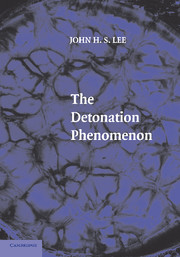Book contents
- Frontmatter
- Contents
- Preface
- 1 INTRODUCTION
- 2 GASDYNAMIC THEORY OF DETONATIONS AND DEFLAGRATIONS
- 3 DYNAMICS OF DETONATION PRODUCTS
- 4 LAMINAR STRUCTURE OF DETONATIONS
- 5 UNSTABLE DETONATIONS: NUMERICAL DESCRIPTION
- 6 UNSTABLE DETONATIONS: EXPERIMENTAL OBSERVATIONS
- 7 INFLUENCE OF BOUNDARY CONDITIONS
- 8 DEFLAGRATION-TO-DETONATION TRANSITION
- 9 DIRECT INITIATION OF DETONATIONS
- Epilogue
- Index
8 - DEFLAGRATION-TO-DETONATION TRANSITION
Published online by Cambridge University Press: 06 July 2010
- Frontmatter
- Contents
- Preface
- 1 INTRODUCTION
- 2 GASDYNAMIC THEORY OF DETONATIONS AND DEFLAGRATIONS
- 3 DYNAMICS OF DETONATION PRODUCTS
- 4 LAMINAR STRUCTURE OF DETONATIONS
- 5 UNSTABLE DETONATIONS: NUMERICAL DESCRIPTION
- 6 UNSTABLE DETONATIONS: EXPERIMENTAL OBSERVATIONS
- 7 INFLUENCE OF BOUNDARY CONDITIONS
- 8 DEFLAGRATION-TO-DETONATION TRANSITION
- 9 DIRECT INITIATION OF DETONATIONS
- Epilogue
- Index
Summary
INTRODUCTION
The two combustion modes of deflagration (flame) and detonation can be generally distinguished from each other in a number of ways: by their propagation speed, the expansion (deflagration) versus compression (detonation) nature of the wave, subsonic (deflagration) versus supersonic (detonation) speed relative to the mixture ahead of the wave, and the difference in the propagation mechanism. A deflagration wave propagates via the diffusion of heat and mass from the flame zone to effect ignition in the reactants ahead. The propagation speed is governed by heat and mass diffusivity, and the diffusion flux is also dependent on the reaction rate that maintains the steep gradient across the flame. On the other hand, a detonation wave is a supersonic compression shock wave that ignites the mixture by adiabatic heating across the leading shock front. The shock is in turn maintained by the backward expansion of the reacting gases and products relative to the front, thus providing the forward thrust needed to drive the shock. A propagating flame generally has a precursor shock ahead of it, and the flame can therefore propagate at supersonic speeds with respect to a stationary coordinate system. In theory, there is still a pressure drop across the flame itself, but there may still be a net pressure increase in the products across the shock–flame complex with respect to the initial pressure of the reactants.
- Type
- Chapter
- Information
- The Detonation Phenomenon , pp. 250 - 296Publisher: Cambridge University PressPrint publication year: 2008
- 4
- Cited by



